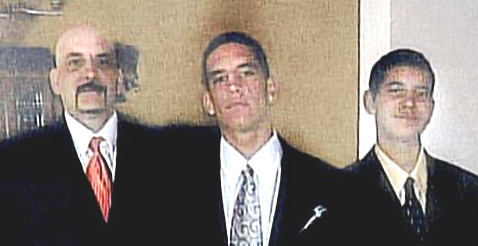05/10/2012
One of the worst cases ever of a preventable crime by a previously arrested but not deported illegal alien gangster came to a near-conclusion today in San Francisco. Edwin Ramos was convicted of murdering Tony Bologna and his two sons (pictured below) in a mistaken-identity gang hit nearly four years ago.
There could have been no mistake that Ramos was a dangerous criminal. He was a member of MS-13, known to be one of the most violent gangs, and was an illegal alien. He had been found guilty as a juvenile of two felonies: a gang-related assault on a Muni passenger and the attempted robbery of a pregnant woman. But San Francisco coddled rather than deported a very dangerous man, and the Bologna family was the victim of government malfeasance. The city sanctuary policy dictated that the legal system would not concern itself with Ramos’ immigration status, so he has allowed to remain in America and kill.

For more background, see my 2008 article, San Francisco Triple Murder Highlights Immigrant Crime Wave.
Uber-liberal San Francisco doesn’t do death penalties even in the most brutal cases, so Ramos will likely be sentenced to life in state prison, where he will be have plenty of fellow Hispanic gangsters for company.
Ramos convicted of killing S.F. man and his sons, San Francisco Chronicle, May 9, 2012Alleged gang member Edwin Ramos was convicted Wednesday of the slayings of a San Francisco father and his two sons, the culmination of one of the most notorious crimes in the city in recent years.
The San Francisco Superior Court jury returned guilty verdicts to three first-degree murder counts in the killings of Tony Bologna, 48, and his sons Michael, 20, and Matthew, 16, who were shot to death while driving home in the Excelsior neighborhood on a bright Sunday afternoon June 22, 2008.
The jury heard three months of testimony in the case before beginning deliberations last Wednesday on the 25-year-old Ramos’ fate.
The case first drew widespread attention for its random brutality. It became a national story when The Chronicle reported that city juvenile-justice officials relying on San Francisco’s sanctuary-city policy had twice shielded Ramos, a suspected illegal immigrant from El Salvador, from possible deportation after he committed gang-related crimes as a minor.
Assistant District Attorney Harry Dorfman, the lead prosecutor on the case, portrayed Ramos as a seemingly charming but cold-blooded killer who shot the Bolognas in a misguided attempt to avenge a compatriot in the MS-13 gang who had been shot and wounded earlier that day.
“You are looking at a murderer, a gang murderer,” Dorfman told the jury in his closing argument, pointing to Ramos. “Hold him responsible for all the sorrow and grief he caused that day.”
With no murder weapon or ballistics tests to link Ramos to the shootings, the prosecution relied heavily on the testimony of Tony Bologna’s son Andrew Bologna, 21, the only survivor of the attack. He testified that the family had been returning from a gathering in Fairfield when Ramos blocked their car at Congdon and Maynard streets in his Chrysler 300, then rolled alongside and opened fire.
The district attorney said Ramos had mistaken at least one of the Bologna sons for an MS-13 rival — in fact, none belonged to a gang. Prosecutors brought in an assortment of gang members and their girlfriends, many of whom were granted immunity, to describe the gang world in which Ramos lived.
Ramos’ legal team, headed by Marla Zamora, said he had left gang life and associated with MS-13 members only to sell them drugs.
Zamora said Ramos was the fall guy for the real killer, Wilfredo “Flaco” Reyesruano, the now-vanished leader of a faction of the MS-13 gang.
Ramos, who took the stand in his own defense, testified that he had been driving Reyesruano to the hospital to visit their wounded gang friend but had gotten lost in the Excelsior trying to find the freeway. When they encountered the Bolognas, he said, Reyesruano yelled gang epithets and, without warning, opened fire.
Ramos “didn’t know what Wilfredo was going to do that day,” Zamora told the jury.
In portraying him as an innocent, the defense downplayed Ramos’ history as a juvenile offender. Ramos was not in the United States legally at the time he was identified as one of three alleged MS-13 members who beat up a man on a Muni bus in the Mission District in 2003. Prosecutors told the jury that Ramos and his gang colleagues had been “checking” passengers to determine what gang they were affiliated with.
Instead of referring him to federal authorities for possible deportation, San Francisco juvenile authorities placed Ramos in a shelter and later released him to his mother in April 2004.
Four days after his release, he assaulted a pregnant woman and her brother, and was sentenced to the city’s Log Cabin Ranch for felony attempted robbery. He was released in February 2005, again without city juvenile authorities reporting him to federal immigration officials.
The Juvenile Probation Department had ordered employees not to report minors to immigration officials under the agency’s interpretation of San Francisco’s sanctuary policy, which barred city officials from cooperating with deportations.
The revelations about Ramos’ history of juvenile offenses fueled a controversy over the policy, and ultimately led then-Mayor Gavin Newsom to order that all undocumented juvenile offenders be reported to immigration officials.
The policy has since been eased to allow authorities to exercise discretion in deciding whether to report offenders.
Tony Bologna’s widow, Danielle, sued the city in 2009, claiming that officials’ interpretation of the sanctuary policy had led to the killings of her husband and sons. A judge threw out the suit, ruling that officials were not responsible for any crimes Ramos may have committed.
Vivian Ho and Jaxon Van Derbeken are San Francisco Chronicle staff writers.,
This is a content archive of VDARE.com, which Letitia James forced off of the Internet using lawfare.